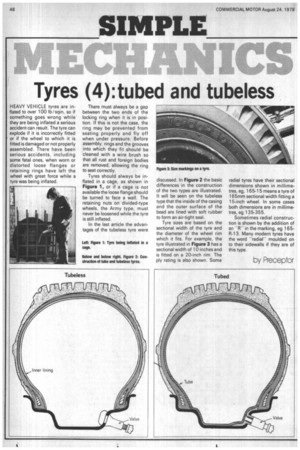Tyres (4):tubed and tubeless
Page 50

If you've noticed an error in this article please click here to report it so we can fix it.
HEAVY VEHICLE tyres are inflated to over 100 lb isqin, so if something goes wrong while. they are being inflated a serious accident can result. The tyre can explode if it is incorrectly fitted or if the wheel to which it is fitted is damaged or not properly assembled. There have been serious accidents, including some fatal ones, when worn or distorted loose flanges or retaining rings have left the wheel with great force while a tyre was being inflated.
There must always be a gap between the two ends of the locking ring when it is in position. If this is not the case, the ring may be prevented from seating properly and fly off when under pressure. Before assembly, rings and the grooves into which they fit should be cleaned with a wire brush so that all rust and foreign bodies are removed, allowing the ring to seat correctly.
Tyres should always be inflated in a cage, as shown in Figure 1, or if a cage is not available the loose flange should be turned to face a wall. The retaining nuts on divided-type wheels, the Army type, must never be loosened while the tyre is still inflated.
In the last article the advantages of the tubeless tyre were discussed. In Figure 2 the basic differences in the construction of the two types are illustrated. It will be seen on the tubeless type that the inside of the casing and the outer surface of the bead are lined with soft rubber to form an air-tight seal.
Tyre sizes are based on the sectional width of the tyre and the diameter of the wheel rim which it fits. For example, the tyre illustrated in Figure 3 has a sectional width of 10 inches and is fitted on a 20-inch rim. The ply rating is also shown. Some radial tyres have their sectional dimensions shown in millimetres, eg, 1 65-1 5 means a tyre of 165mm sectional width fitting a 15-inch wheel. In some cases both dimensions are in millimetres, eg 135-355.
Sometimes radial construction is shown by the addition of an "R" in the marking, eg 1 65R-13. Many modern tyres have the word "radial" moulded on to their sidewalls if they are of this type.
by Preceptor








































































































